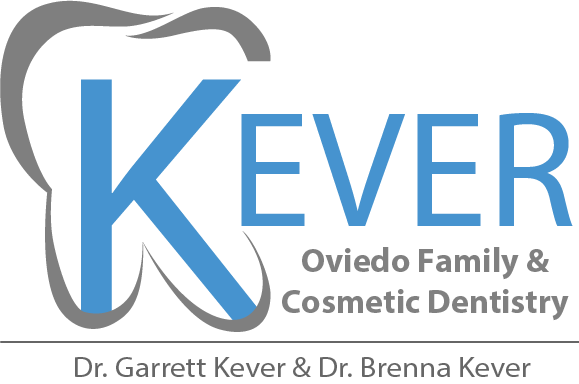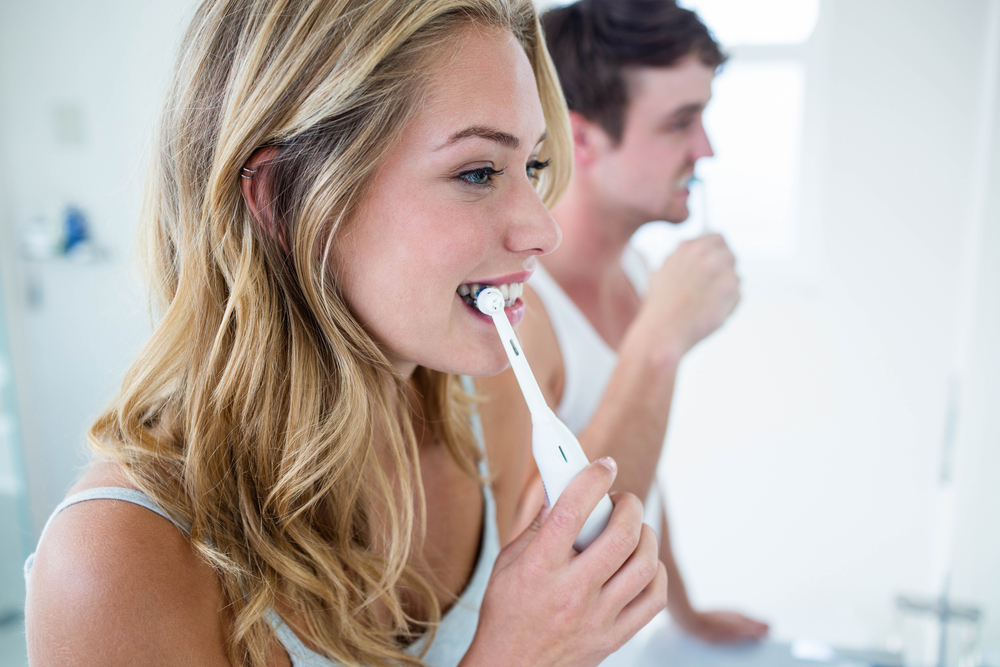The Essentials: Floss, Brush, Rinse.
- Does the order of brushing and flossing matter?
- The scientists at the American Dental Association say no, the brushing and flossing order does not really matter as long as you do a thorough job of each. Brenna and Garrett Kever both floss and brush in different orders… we won’t tell you who does which, but their teeth are pretty healthy.
- Brushing
- Twice a day for two minutes with a soft-bristled toothbrush (we feel that anything more than “soft” should only be used on grout)
- Place your toothbrush at a 45-degree angle, with bristles resting on tooth structure but pointed towards your gums. Move in short, tooth-wide circular strokes. Brush the outside, inside, and chewing surfaces of the teeth.
- Brushing at a 45-degree angle ensures your bristles are gently sweeping along the gumline at the same time as they are brushing the teeth.
- Do not splash water in your mouth after brushing. This will rinse fluoride away from the teeth. Simply spit out excess toothpaste, and you’re all set.
- Pro Tips:
- If you have a habit of brushing too hard, begin on the chewing surfaces of the teeth. We tend to exert the most force at the beginning of each brushing session.
- Brush in front of a mirror! Watching yourself brush keeps you focused, and prevents missing areas. Pull back your lips and visually inspect your work at the end- missed areas may have soft white plaque deposits visible.
- Most commonly missed areas for our patients:
- Cheek side of the upper back molars. The jaw bone makes this area very tight for the toothbrush to reach. How to reach this area: as you’re open wide, close halfway and shift your lower jaw to the side. You’ll find that this will move the jaw bone out of the way and allow you to better reach the side of those upper molars.
- Behind the lower front teeth. Your salivary glands shoot saliva from ducts directly behind these teeth. That means these teeth are particularly prone to mineral deposits. Be sure to run your toothbrush vertically behind your lower front teeth.
- ADA reference with pictures of proper brushing technique: https://www.mouthhealthy.org/~/media/MouthHealthy/Files/Kids_Section/ADAHowToBrush_Eng.pdf?la=en
- Flossing
- Floss at least once a day.
- Ensure you are adapting the floss and “squeegee-ing” along the side of the tooth, sliding along the side of the tooth until you meet resistance under the gums. Squeegee the side of the tooth next door before you pop floss back through.
- Rinsing
- When to rinse? There is a lot of debate between different health organizations about the order of rinsing after brushing. The best advice is to check the label on your mouthwash to maximize its efficacy. We feel that if you are brushing, flossing, using mouthwash, and getting regular dental checkups (with good reports), you’re probably doing just fine.
- Children younger than six years old should not use mouthwash.
Children and Dental Care
- When should I start brushing my children’s teeth?
- American Academy of Pediatric Dentistry states: “The sooner the better! Starting at birth, clean your child’s gums with a soft infant toothbrush or cloth and water. Parents should use a tiny smear of fluoride toothpaste to brush baby teeth twice daily as soon as they erupt and a soft, age-appropriate sized toothbrush. Once children are 3 to 6 years old, then the amount should be increased to a pea-size dollop and perform or assist your child’s brushing. Remember that young children do not have the ability to brush their teeth effectively. Children should spit out and not swallow excess toothpaste after brushing.”
- How much toothpaste?
- Unable to spit predictably, or younger than 3 years old- tiny smear of toothpaste
- Over 3 years old, and able to spit predictably- “pea sized” amount of toothpaste
- Should kids floss?
- As soon as teeth start touching each other, children need to floss daily. Using floss picks may be easier until kids get the hang of flossing.
- When should I help my child brush/floss until?
- Likely until they are at least seven years old.
- The “Oreo test” is a fun test to see if your child is ready for independent brushing and flossing. Give your child an Oreo to eat, then ask them to brush and floss their own teeth. If there is any residue left, they are not ready for independent oral care. Alternatively, they can use a plaque disclosing tablet after brushing for the same test. The tablets will stain any remaining plaque a bright color they can easily see to clean off.
- When should my child see a dentist?
- Children should see a dentist when they get their first tooth, or around their first birthday- whichever happens first.
Childrens’ Toothpaste Recommendations
Kids’ toothpaste has the same level of fluoride as adult toothpaste, they just use a different amount depending on their ability to expectorate (spit).
- General toothpaste recommendations with kid-friendly flavors and characters:
- Colgate Kids, Crest Kids
- Low SLS/foaming toothpaste, minimal additives, with fluoride, kid friendly flavor:
- Burts Bees for Kids
- Tom’s Childrens
- Tanner’s Tasty Paste
- Hello
- No flavors, no foaming/ SLS, with fluoride; great for kids with ASD/ Sensory Processing Disorders:
- OraNurse
Pediatric recommendations given by Dr. Yoshita Patel, Pediatric Dentist.
Adult Toothpaste Recommendations
- No SLS/foaming, ADA Accepted:
- Sensodyne formulations: Extra Whitening, Fresh Mint, Full Protection, Tartar Control, Fresh Impact
- No SLS/ foaming, ADA Accepted, and free of triclosan, parabens, artificial flavors/ sweeteners, preservatives, and blue, red, and yellow dyes:
- Burt’s Bees Enamel Care
- Hello Naturally Whitening Fluoride Toothpaste– Additionally, this toothpaste is vegan and cruelty-free. Does not contain: dyes, peroxide, gluten, or BPA. This is the toothpaste our dentists use at home.
Why is the ADA Acceptance seal important?
Toothpastes with this seal have gone through rigorous scientific testing and are proven to have the correct level of abrasivity and fluoride release for oral health. Products with this seal also do not contain any flavoring agents that contribute to tooth decay.
But, what about charcoal?
Charcoal toothpastes are generally too abrasive and can wear away your enamel over time. They may initially make your teeth feel slick, but loss of enamel will allow the yellow dentin layer to show through, causing permanent yellow appearance of the tooth.
Favorite Products
We are frequently asked preferences on toothpastes, toothbrushes, mouthrinses, and general oral hygiene practices. Here is a quick reference guide on what we like to clean those pearly whites!
Toothbrushes:
We find that electric toothbrushes generally clean better than manual toothbrushes. We like the brands with a history of research behind them, so we recommend Sonicare, or OralB IO Series electric toothbrushes. Remember, good brushing technique is essential with any toothbrush.
For some patients, a manual toothbrush may be recommended due to particular considerations with their gum tissue. A thorough assessment by a dental professional is necessary to determine if a manual toothbrush would be necessary.
Tongue Cleaner:
Cleaning your tongue (with a gentle scraping motion from back to front) can help reduce bad breath odors. A 2022 study6 found that there was no difference in the efficacy of tongue cleaning with a toothbrush vs. tongue scraper. That being said, tongue scrapers have a broader surface area and need fewer passes on the tongue surface to achieve the same result- meaning less potential for gag reflex stimulation.
Water Flosser:
We love water flossers as an adjunct to traditional dental floss. We frequently recommend WaterPik as an adjunct for flossing- particularly for patients with bridgework, braces, or implants.
Plaque Disclosing Tablets:
If you find you are continually missing areas of your mouth, consider using plaque disclosing tablets after brushing. We frequently recommend these for children, orthodontic patients, and even adults who are habitually missing certain areas of their mouth. The tablets are designed to colorize missed plaque, so you can see where you’ve missed, and brush off the plaque. Simply chew up the tablet, spit in the sink, and look in the mirror to see the areas you’ve missed. These can frequently be purchased in the toothpaste aisle, or at major retailers online.
Pro tip: once you’ve improved your brushing technique, set a reminder on your phone calendar at a two week interval. When the alert goes off, do a plaque disclosing tablet check to see how well you’re maintaining the habit.
Ready to take control of your oral health? Call or text our office at 407-366-3799 to set up an appointment.
This article is intended to promote understanding of and knowledge about general oral health topics. It is not intended to be a substitute for professional advice, diagnosis or treatment. Always seek the advice of your dentist or other qualified healthcare provider with any questions you may have regarding a medical condition or treatment.
References:
- https://www.ada.org/resources/research/science-and-research-institute/oral-health-topics/floss#:~:text=Should%20I%20brush%20or%20floss,with%20floss%20between%20their%20teeth.
- https://www.mouthhealthy.org/~/media/MouthHealthy/Files/Kids_Section/ADAHowToBrush_Eng.pdf?la=en
- https://www.ada.org/resources/research/science-and-research-institute/oral-health-topics/mouthrinse-mouthwash
- https://www.aapd.org/resources/parent/faq/#:~:text=Parents%20should%20use%20a%20tiny,or%20assist%20your%20child’s%20toothbrushing.
- https://www.aapd.org/assets/news/upload/2009/3696.pdf
- https://www.ncbi.nlm.nih.gov/pmc/articles/PMC8751028/

